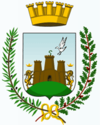Oria (town)
| Oria | ||
|---|---|---|
| Comune | ||
| Comune di Oria | ||
 |
||
|
||
| Location of Oria in Italy | ||
| Coordinates: 40°30′N 17°38′E / 40.500°N 17.633°E | ||
| Country | Italy | |
| Region | Apulia | |
| Province / Metropolitan city | Brindisi (BR) | |
| Government | ||
| • Mayor | Cosimo Ferretti | |
| Area | ||
| • Total | 83 km2 (32 sq mi) | |
| Elevation | 83 m (272 ft) | |
| Population (31 December 2014) | ||
| • Total | 15,357 | |
| • Density | 190/km2 (480/sq mi) | |
| Demonym(s) | Oritani | |
| Time zone | CET (UTC+1) | |
| • Summer (DST) | CEST (UTC+2) | |
| Postal code | 72024 | |
| Dialing code | 0831 | |
| Patron saint | Barsanuphius of Palestine | |
| Saint day | August 29 | |
| Website | Official website | |
Oria (or Orra, Greek: Ὑρία - Hyria, Οὐρία - Uria) is a town and comune in the Apulia region, in the province of Brindisi, in southern Italy. It is the see city of the Roman Catholic Diocese of Oria.
In classical times, Oria was known as Hyria (Uria) or Hyrium, a city in ancient Messapia and one of the principal Messapian cities. It was just north of the ancient town Manduria, at some distance southwest of Brundisium, and southeast of Taras/Tarentum; corresponding to the location of the modern town.
According to Herodotus (7.170), it was founded by the Messapians (who according to Herodotus were originally Cretans) sometime after the abortive siege of the Sicanian city Camicus. Between 217 and 84 BC the city was minting its own coins. The coins often feature Iapagus, the Iapygian national hero.
Hyria was conquered by the Romans. It was destroyed in AD 924 and 977. In 1266, Oria was besieged by Manfred of Sicily.
Oria had one of the oldest Jewish communities in Europe. Jewish scholarship in Oria included the study of philosophy, the Talmud, languages such as Greek and Latin, and medicine and natural sciences. It was home to Shefatya ben Amitai and Shabbethai Donnolo, one of the first Hebrew writers who was native to Europe.
...
Wikipedia


